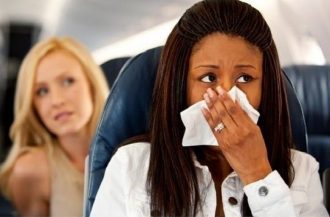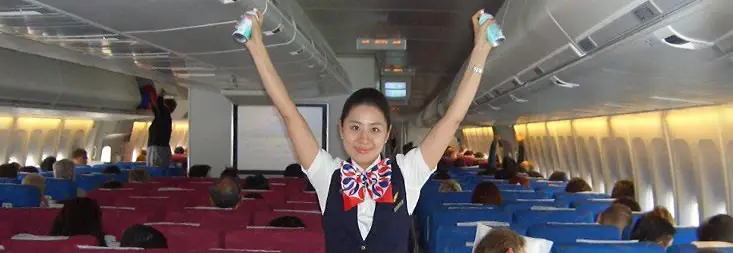Contributing writer for Wake Up World
On my first trip to India about a decade ago, I distinctly remember when the plane landed, the interior of the aircraft was sprayed by the flight attendants — with all the passengers still in it. A vague announcement had been made beforehand, claiming everything needed to be disinfected. At the time, I wasn’t thrilled about some unknown aerosol being forced upon us, but promptly forgot about it. I never encountered it again during subsequent international air travel, and simply thought it was a fluke with that particular flight.
Jump to the present and a series of articles have come across the news wire recently, bringing attention to the fact that the practice is alive and well. But it isn’t always obvious — often, the interior surfaces are treated with a residual spray before passengers board. As it turns out, the aerosol isn’t a disinfectant at all, but actually a pesticide and neurotoxin that has been linked to a range of health issues — like cancer, endocrine disruption and autoimmune disorders.
The Common Practice of Insecticide Use Within Airplane Cabins
The first question that comes to mind regarding the spraying of pesticides on airplanes is a resounding why? Why would insecticides be sprayed throughout a pressurized tube with recirculated air, where people — children, pregnant women and the elderly included — are captive for hours at a time?
[pro_ad_display_adzone id=”110028″]
For the World Health Organization (WHO), the answer is simple: bugs. Those nasty pests who spread unpleasant diseases like malaria, dengue fever, yellow fever — and now the Zika Virus, as well as insects that can seriously damage crops. The practice is known as “disinsection” and it’s considered a public health measure, one that is mandated by International Health Regulations.
As stated by the World Health Organization, the different procedures currently in use are:
- Treatment of the interior of the aircraft using a quick-acting insecticide spray immediately before take-off, with the passengers on board;
- Treatment of the interior of the aircraft on the ground before passengers come on board, using a residual-insecticide aerosol, plus additional in-flight treatment with a quick-acting spray shortly before landing;
- Regular application of a residual insecticide to all internal surfaces of the aircraft [without passengers on-board], except those in food preparation areas.
While the idea of controlling the transport of disease-carrying insects is understandable, the method can hardly be considered a safe, realistic solution — especially since the pesticides used are far from harmless.
Video: Airline Staff Sprays Pesticides On Passengers Inside an Aircraft Cabin
Toxic Air Travel
Phenothrin is a neurotoxin and can increase the risk of cancer, Parkinson’s disease, memory loss, and autoimmune disorders, such as lupus. It’s also one of the insecticides used to control pests on airplanes. Another class are synthetic pyrethroids — namely, permethrin and d-Phenothrin. Both are considered neurotoxins — and both are routinely used for disinsection. Incredibly, up until the 1970s, DEET was the toxin of choice for airplane cabins.
Passengers have reported negative reactions linked to the spraying, including: sinus problems, rashes and hives, headaches, respiratory issues and flu-like symptoms. Anaphylactic shock has also been documented.
“With little ventilation and in such a closed space, spraying pesticides on airplanes while passengers are still on board is troubling, particularly for sensitive groups like children, pregnant mothers, the elderly, and those with chronic conditions,” says Drew Toher Public Education Associate at Beyond Pesticides [source]
According to the U.S. Department of Transportation, the following countries require disinsection of all in-bound flights with an aerosolized spray while passengers are on-board:
- Ecuador (only Galapagos and inter-island)
- Grenada
- Guyana
- India
- Kiribati
- Madagascar
- Panama
- Seychelles
- Tanzania
- Timor-Leste
- Trinidad and Tobago
- Uruguay
- Zimbabwe
Countries requiring the disinsection of all in-bound flights but allowing, as an alternative to the above approach, either (a) the residual method or (b) the application of an aerosolized spray while passengers are not on-board. However, there have been many reports of spraying with passengers still on-board for flights into Australia.
- Australia
- Barbados
- Cook Islands
- Fiji
- Jamaica
- New Zealand
Additionally, the countries below require disinsection on flights from specific locations where contagious disease and zika, malaria, yellow fever and dengue fever are prevalent:
- Czech Republic
- France
- Indonesia
- Mauritius
- South Africa
- Switzerland
- United Kingdom
If you have a question about whether an upcoming flight is at risk for spraying, a list of airline representatives, who are familiar with disinsection requirements, can be found here.
We can also pressure the airlines to adopt less toxic methods to deal with pests — like “air curtains” which blow air towards doorways to prevent insects from entering the plane. As it stands now, the airlines haven’t implemented the technology because it’s more costly than insecticides.
Article sources:
- www.transportation.gov/office-policy/aviation-policy/aircraft-disinsection-requirements
- www.usatoday.com/…/disinsection-airplane-pesticide-spraying/27177835
- www.sciencedirect.com/science/article/pii/0165121895900071
- www.sciencedirect.com/science/article/pii/S0045653502008548
- www.endocrinedisruption.org/about-tedx/about
- www.cdph.ca.gov/…/SafetyofPyrethrinandPyrethroidPesticidesUsedtoControlAdultMosquitoes…pdf [PDF]
- www.who.int/ith/mode_of_travel/aircraft_disinsection/en
- www.truth-out.org/opinion/item/31402-pesticides-on-planes-how-airlines-are-softly-killing-us
About the author:
 Carolanne Wright enthusiastically believes if we want to see change in the world, we need to be the change. As a nutritionist, natural foods chef and wellness coach, Carolanne has encouraged others to embrace a healthy lifestyle of organic living, gratefulness and joyful orientation for over 13 years.
Carolanne Wright enthusiastically believes if we want to see change in the world, we need to be the change. As a nutritionist, natural foods chef and wellness coach, Carolanne has encouraged others to embrace a healthy lifestyle of organic living, gratefulness and joyful orientation for over 13 years.
Through her website Thrive-Living.net, she looks forward to connecting with other like-minded people from around the world who share a similar vision. You can also follow Carolanne on Facebook, Twitter and Pinterest.
Recommended reading by Carolanne Wright:
- Monsanto Strikes Again — Tests Confirm Most Vaccines Contain Glyphosate Herbicide
- The Most Eco-Friendly Nation on the Planet is Now Carbon Negative
- Plastic Waste in the Ocean Will Outnumber Fish by 2050
- Mind Control, Subliminal Messages and the Brainwashing of America
- Monsanto Charged with Crimes Against Nature and Humanity – Set to Stand Trial in 2016
- Plastic-Eating Mushroom Discovered in the Amazon Rainforest — A Solution for Our Trash Saturated World?
- Over 100 Scientific Studies Agree: Cannabis Annihilates Cancer
- Why Every Parent Should Consider Unschooling
- First U.S. City Produces More Electricity Than It Uses — With 100% Renewable Technology
- If You Care About Animals and the Earth, Here’s Why You Need to Boycott Palm Oil Immediately
- Basic Income Guarantee: A Surprisingly Cost-Effective Method for Eliminating Poverty
[pro_ad_display_adzone id=”110027″]








